Crimson Peak plunges deep into a genre that I brutally and gleefully adore: the gothic romance. This modernized take on a traditional theme allows viewers to shove their hands straight into the chest cavity of the culmination of a mass of literary and filmic works. Guillermo del Toro has woven a plethora of references into the body of his motion picture, ranging from the prose of Charlotte Brontë, Sheridan Le Fanu and Daphne Du Maurier to films like Jack Clayton’s The Innocents (1961), Joseph L. Mankiewicz’s Dragonwyck (1946) and George Cukor’s Gaslight (1944). It’s pretty ballsy for a modern motion picture to be made based on Victorian-era supernatural themes, but it’s been done. However, add to it a strong female protagonist, a handsome detached love interest, sexual depravity by way of a severe Mrs. Danvers-Judith Anderson-style character, and you have the gothic spectacle of Crimson Peak.
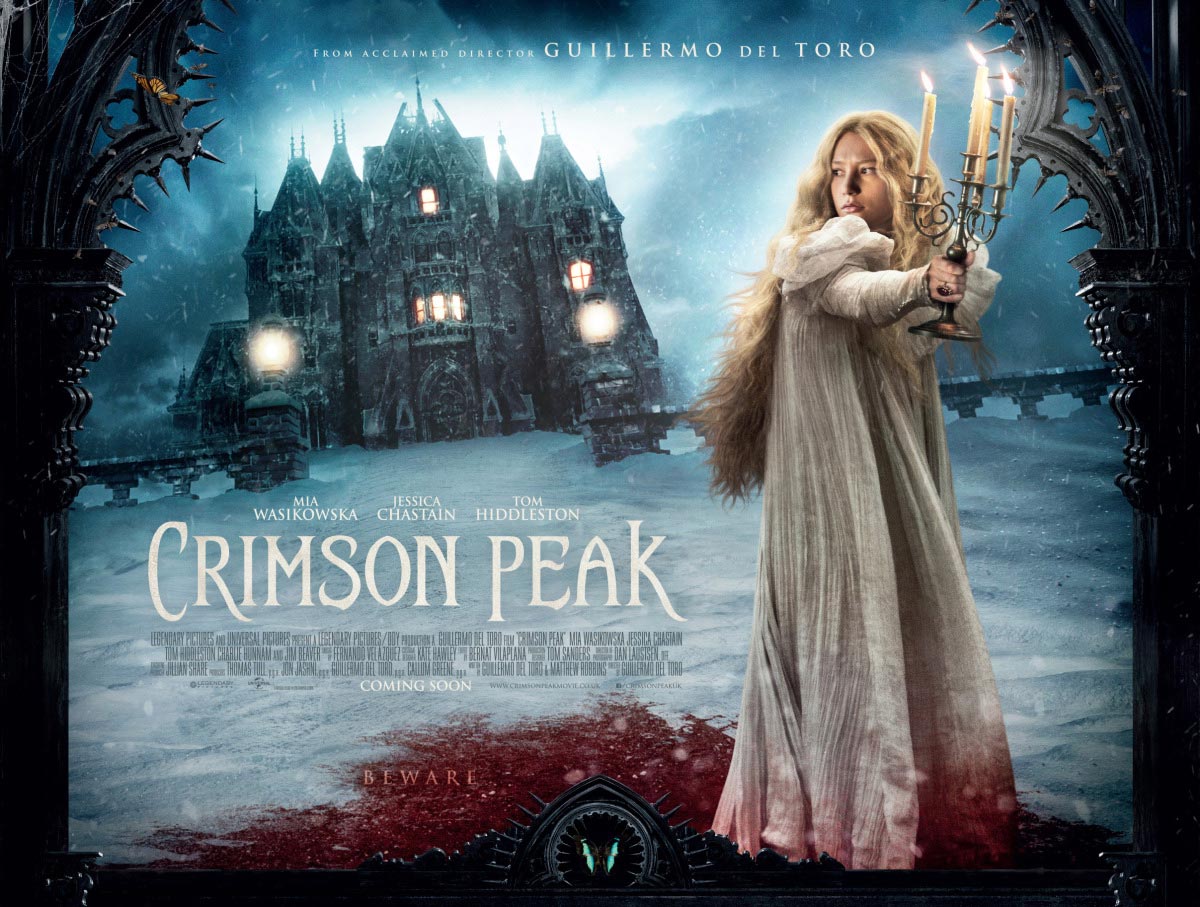
The first line of film dialogue is the intriguing, “Ghosts are real. That much I know,” which sets up the paranormal narrative while the initially spunky female protagonist, Edith Cushing (Mia Wasikowska), quips that she would rather be Mary Shelley than Jane Austen, because “at least she died a widow.” So we have our Edith. She has engaged the audience on two levels: the supernatural and the sexual (Jane Austen never married, therefore it is inferred that she died a virgin). Yet her strengths do not receive much reward. Publishers turn down her writing since it is not romance. The women that she is surrounded by see her as lower class. She herself does not wish to be part of social settings. Until a Tall Dark Stranger by the name of Thomas Sharpe (Tom Hiddleston) comes to town.
I will stop here: we have seen this storyline before. But in previous media iterations the gothic romance was never allowed to let its freak flag fly. That is exactly what del Toro does with Crimson Peak.
The plot for Crimson Peak was the basis for almost every book I bought from the grocery store when I was 11 or 12. Every time my mom and I went shopping, I would immediately run to the rack of books attached to the frozen food section while she went…elsewhere. As we headed towards checkout, I’d pop my selection in her cart. “Ariel, you don’t need another book,” she would say, “That’s what the library is for!” “Just this one!” I would plead. And she would sigh. My mom was right, of course. I didn’t NEED another book. But I WANTED another book. Especially those books. The libraries in LA ran pretty low on these titles because they were (and still are) seen as trashy and low-rent. But I ate them up like candy.

My girlfriends and I call them “bumpy cover books” because, well, that’s what they are. The covers for these publications have embossed and raised lettering thus…bumpy covers. Fabio got most of his fame from modeling for these paperbacks. What are bumpy cover books? Romance novels. And I read them incessantly as a kid. Not because they were good or because they were literary successes but because they were thick and they took just a tiny bit longer to read than the cereal box at breakfast.
What people may not know is that not all romance novels are the same. While the covers may look awkwardly similar (even utilizing the same models in precisely the same physical positions) they are actually quite different. If you look on the spines of each volume, they have different genre specifications. My favorite two were “historical romance” and “gothic romance”/”gothic thriller” (those two were interchangeable). I remember asking my mom to send me a care package at summer camp and have it contain any/all trade paperbacks she could find that said “gothic romance” on the spine. I will give younger me credit for recognizing that all titles cataloged under the “gothic” subject heading had a woman protagonist who was at least slightly empowered. So it is totally unsurprising that when Crimson Peak came around it was just my speed.
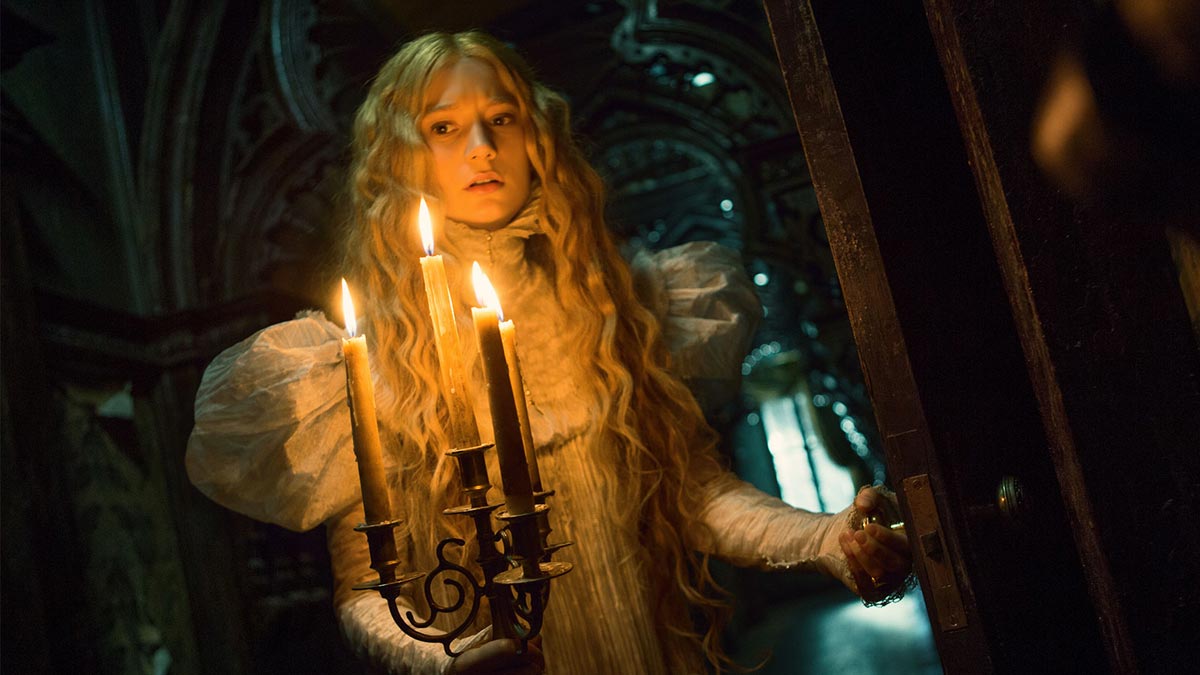
In the discussion that follows, there will be some spoiler-y info about Crimson Peak. If you’re not into that, here’s your opportunity to get out and thanks for reading thus far!
If I could give Gothic Thriller/Romance heroines a list of Survival Tips, this would be it:
- Don’t marry that super hot stranger from out of town. Just don’t do it. Oh god. You did it. Ok. Let’s move on to…
- Do not eat or drink anything that his housekeeper or sister or cousin or relative of any kind gives you. It’s bad for you. Oh man. You did that too. So…
- Talking with Super Hot Husband isn’t working and he’s doing things that seem Super Strange. Oh, he won’t tell you about it? You probably should seek outside assistance. Write home. If you’re not an orphan, that is. If orphaned, skip to 5.
- Make sure that letter home is sent through a trusted source. I mean, definitely don’t let anyone else in the house see that you’re trying to contact the outside world, like the housekeeper/relative/sister/cousin.
- When it’s clear that no one’s coming to help you, it’s 100% fine to take things into your own hands and freak the fuck out. Chances are that your husband is actually on Team You, but you can’t be sure.
- Protect yourself and the child that you may/may not be carrying and be ready to have a hell of a fight. If that happens, it is likely that you will have a knock down drag-out run-around brawl either inside the mansion/estate or outside on the cliffs in your nightgown and flowing bedclothes. Maybe both places. Be prepared.
- You will probably survive, no guarantees on anyone else.
Crimson Peak fits comfortably into this genre. It falls smack dab in between the sensationalism of bumpy cover gothic thrillers and the “classy” works like Charlotte Brontë’s Jane Eyre. Its specific use of blood and carnage reminds us vividly that we are not in the polite literary or filmic confines anymore and takes the gothic thriller one critical step further: it points out the genre’s corporeal connection to women. After all, women’s bodies bleed and so does the body of Crimson Peak. The ghosts drip with blood, maternal imagery and female-ness. The house, Allerdale Hall, a character unto itself, is bleeding constantly, shown against the white snow.
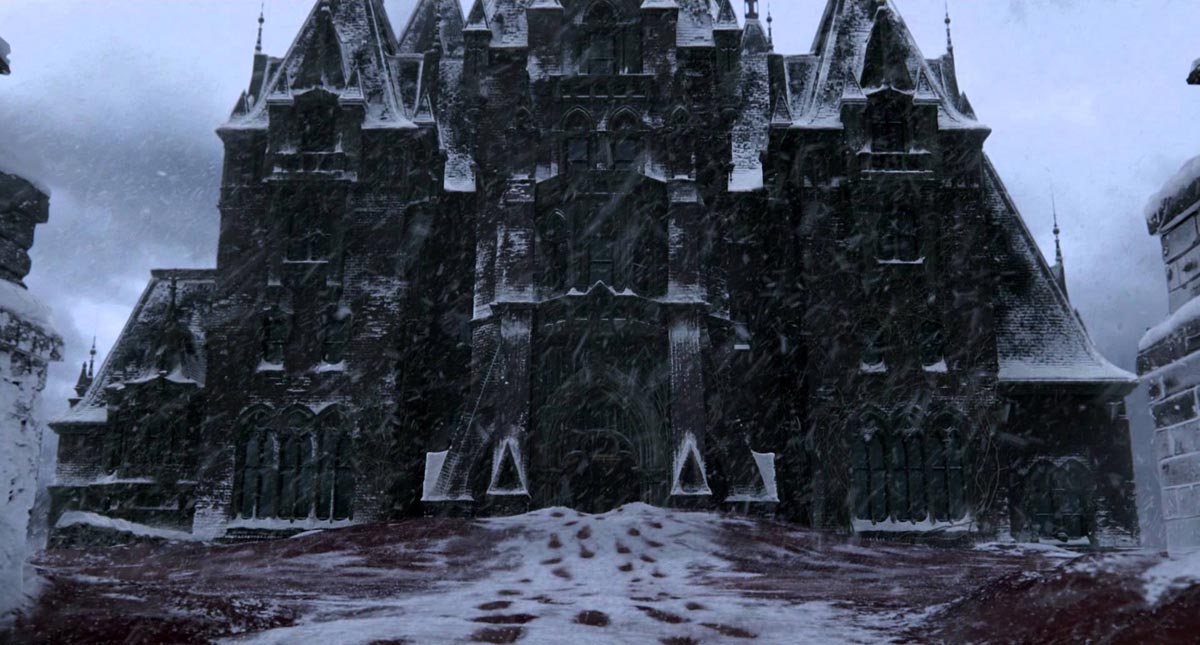
The gothic romance has always been a women’s genre. Written by women, centered on women, developed by women, starring women, it is incredibly gynocentric. While some of the works have been directed/produced/written by men and technically all the Brontë sisters’ works were first published under male pseudonyms, the films, short stories, books and other media are focused entirely on the female experience.
Crimson Peak is no exception. While being a Guillermo del Toro film, this is most definitely a motion picture that examines women living under the nightmare of patriarchy. It evaluates ideas of shame, loss of identity, and dramatically platforms the rage borne directly from a lifetime of male domination. The characters of Edith and Lucille (Jessica Chastain) serve as different manifestations of “woman,” in their displays of sexuality, survival skills and interpersonal engagement. While the film’s visual schema sets the women up in traditional binaries of light/dark, good/evil, warm/cold, the narrative and their performances complicate this, allowing for a much deeper read.
The performed sexuality of each woman is critical. Edith is passionate, warm, openly desiring her husband. When their wedding vows are finally consummated, it is a scene that shows her pleasure and, noticeably, the sex does not take place within the rotting Allerdale Hall. Lucille, on the other hand, is Puritanical about sex. Until she isn’t. Edith discovers her locked in a passionate sexual embrace that screams impropriety and horror. The entire scene drips with forbidden lust, and Lucille’s eyes and face read no apology for her deviance. Edith has discovered Lucille’s Dirty Little Secret but Lucille doesn’t give a shit. She just wants to fuck.
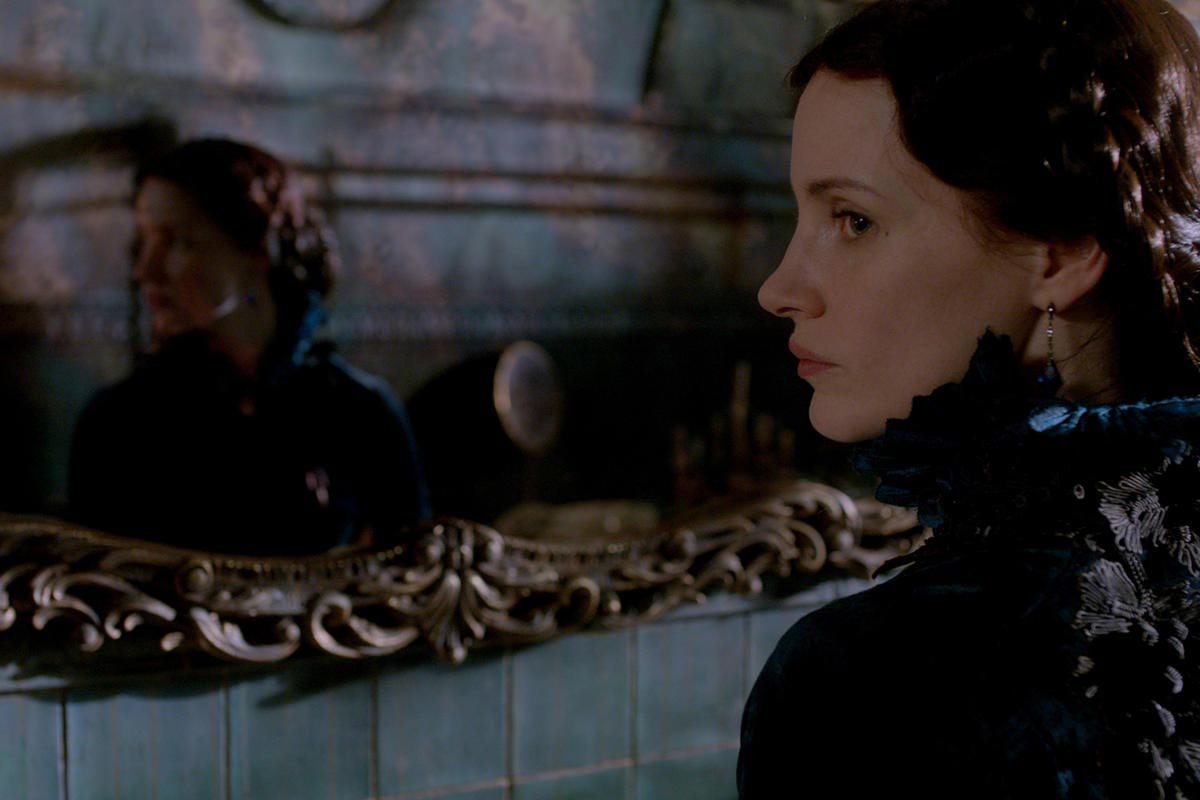
Edith is happy and married; her sexuality is healthy. Lucille is damaged and single; her sexuality is diseased. What does this speak to for women and our lived experience? While the “reveal” of Lucille’s sex scene shows it to be aberrant (perhaps even stomach-turning), on a larger level, she represents women who are shamed for expressing unorthodox sexual desires. Lucille’s character, broken, abused, lonely, violent, is no more evil than the house she was raised in and within whose rooms she finds solace. Her cravings may be socially unacceptable, but she does not see them as such.
Both women are running away from traditional forms of femininity and seeking out personal empowerment. Edith is trying to secure her identity as an author (although she is met with stumbling blocks on the way) and Lucille…well, she’s got her own personal goals having to do with certain “family values.” In her own monstrous way, Lucille is trying to get the power back that was taken from her as a child. One thing is certain: neither of these women is fragile.
It is during the scenes where Edith and Lucille go one-on-one and battle each other in the decrepit and deteriorating house that once stood so proud that we realize what we are seeing and what we have been watching; we see what gothic horror and gothic romance centers on.
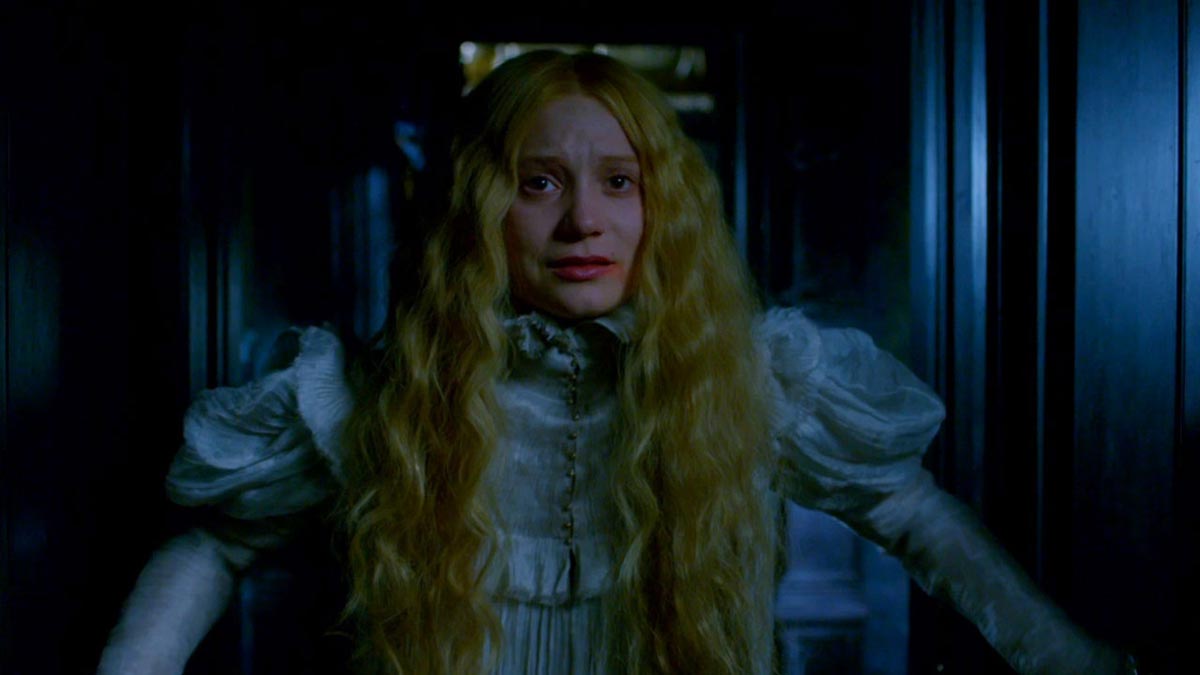
As Edith and Lucille rage furiously against one another (refer to Gothic Romance Survival Tip Number 6), long hair flowing, nightgown skirts billowing around their legs and preposterously large sleeves covering their arms, what seemed like a simple Victorian-era catfight evolves into a life-or-death brawl about female identity and survival. It’s a real shit-kicker throwdown. In pajamas.
They’re right to be pissed. Both Edith and Lucille have, throughout their lives, suffered due to men. Whether it was Edith’s father controlling her love life or Lucille’s broken family, these women have been seething since they were children. Lucille has made the attempt to recoup her losses and live with (or feed on) the rage while Edith has managed to ignore it since she lived in polite society. It is only at this point, in this bloody space filled with reminders of death and sex and womanhood that they finally explode. Filled with equal parts betrayal and pain caused by the men in their lives, they assault each other, allowing this action sequence to serve as the film’s denouement.
Crimson Peak is an incredible film. It discusses how women see themselves as monsters or monstrous (see Lucille’s dialogue). It studies the maternal instinct and the development of coping mechanisms. It investigates how “proper” society treats unconventional and/or creative women and it accentuates the toxicity of familial abuse. It is also a visual splendor to see on the big screen, especially in 35mm. Guillermo del Toro doesn’t fuck around. This dark gothic romance is centered firmly in del Toro’s fairytale horror world. I’m intensely grateful that my bumpy cover books got such a great feminist treatment.


